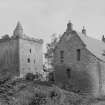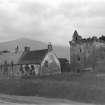Old Sauchie, House
House (17th Century)
Site Name Old Sauchie, House
Classification House (17th Century)
Alternative Name(s) Sauchie
Canmore ID 219418
Site Number NS89NE 120
NGR NS 89593 95695
Datum OSGB36 - NGR
Permalink http://canmore.org.uk/site/219418
- Council Clackmannan
- Parish Alloa
- Former Region Central
- Former District Clackmannan
- Former County Clackmannanshire
NMRS REFERENCE:
Situated to the W of Sauchie Tower, the house dated from the 17th century but was built from the remains of the barmkin wall of Sauchie Tower, which is much earlier, 1420.
Mostly demolished and undistinguished house built c. 1960
Field Visit (29 June 1928)
Old Sauchie House.
The 17th-century house lies 25 yards to the west of the tower. It is oblong on plan and two storeys high, with a round tower, now truncated, projecting from the north-western angle (SC 1168016). The southern end has been replaced by a late cottage. The lower parts of the west wall and tower are evidently the remains of a barmkin, which has been protected by a ditch, still traceable on the western side. In the old walling are three loops, circled at head and foot. The upper floor of the house is entered from the forestair and porch (SC 1168004). The pediment of the porch is elaborately carved and contains at the apex a representation of a pelican in piety set in a tree with three chickens below. Beneath this is a panel with the initials A.S. and the inscription I . MEIN . WEILL surmounting the date 1631, and a shield supported by two 'wodehouses' or wild men who bear scrolls inscribed: dexter in reversed or 'looking-glass' writing : BY PROMIS / MADE / RESTORED / VE / BE, and sinister TO HA[VE A] BLESED ETERNAT[Y]. The shield is charged with three covered cups, for Shaw of Sauchie. The pediments of two dormers beside the porch are also carved. The northern, triangular in shape, is enriched with scroll-work and bears a rude representation of a stand of arms or trophy; in the lower part is the motto: JE ME CONTENTE. The southern pediment is semi-circular and bears a rude shell ornament with the motto EN BIEN FAISANT: it has a stepped finial carved with a figure carrying a sickle in the left hand and a sheaf of corn in the right. The eastern skew-puts bear human heads, and the southern has also the date 1631. The interior of the upper floor has been modernised. The lower floor consists of three vaulted chambers, the northern one opening into the vaulted ground floor of the circular tower. At one time it also opened into another structure projecting eastward, but this was removed, and the opening has been closed by a large kitchen fireplace, which has subsequently been reduced in size. Since this account was prepared, the house has been mostly demolished.
RCAHMS 1933, visited 29 June 1928.
Excavation
NS89NE 120 NS 896 957
A community excavation was undertaken between March and September 2005 in association with the Friends of
Sauchie Tower, the ultimate intention being to consolidate and interpret the site, repair the tower and make it publicly accessible. Following clearance of extensive undergrowth, topographic survey was extended over the core area of the site and beyond to the W, N and E. This clearly recorded the defensive ditch running along the W side of the ruins, and the extent of an artificial terraced platform along the N side of the site.
Six evaluation trenches were located across the site in order to determine archaeologically significant levels. General excavation encompassed the area along the N side of the tower, extending westwards to Old Sauchie House (NS89NE 120), and southwards (along the W side of Sauchie Tower; NS89NE 1). The S chamber and much of the N chamber of the N-S aligned Old Sauchie House were cleared of collapse (demolition debris of c 1930) down to floor level. The standing walls of the ruined structure were also cleaned and the whole recorded.
In the latter stages of excavation a number of individual sondages were excavated to address specific questions; these included more major trenches - to further define the N boundary of the defended site, and to examine the defensive ditch and the junction of the W wall of Old Sauchie House with a round tower at its NW corner.
Early to mid-15th century.
The N and W limits of the defended area of the site were confirmed. To the N, the footings of a masonry enclosure wall were identified at four points and found to be most likely coeval with the surviving W wall of Old Sauchie House. The main area of ground along the N side of the excavation area revealed the remains of a continuous E-W range that had
evidently formed the N side of a courtyarded enclosure. From W to E this contained a probable chamber (now mostly subsumed by the later Old Sauchie House), a great hall (opposed to the laird's hall within the tower), a kitchen and a probable bakehouse, the latter immediately N of the tower.
The hall was defined to the E and W by the remains of internal cross-walls. Its high end to the W had been impacted by numerous later constructions and services, and remains to be excavated more fully. Further E, the impressions of a finely laid polished sandstone floor were revealed throughout, with occasional areas of actual paving in situ. Central to the hall area was a probable open hearth.
To the SE the threshold survived of an entrance off the courtyard; this led to an angled step down to the interior. There were indications that there had been a N-S screen at the E end of the hall - post-holes corresponding to a change in the layout of the paving.
The kitchen at the E end of the hall was identified on the basis of a single remaining jamb of a very broad arched fireplace in the W wall, and the extensive scorching of the paved area within. The kitchen was entered off the courtyard from the SW, where a threshold remained. A presumed entrance between the kitchen and the low end of the hall no longer survived. On the N side of the tower, the range was found to have extended further eastwards beyond the limit of excavation. Within the excavated area, the rectangular masonry base of a probable bake-oven was exposed (partly overlain by a circular successor).
To the S of the hall range a large area of courtyard cobbling was exposed; this incorporated a system of open drains that extended to the NE, into a small cobbled court between the bakehouse and the tower.
While Sauchie Tower itself appears to have been the first construction evident on the site, it is suggested that the surrounding courtyard complex is broadly coeval (thus early to mid-15th century), in spite of the fact that there are no apparent tie-ins to the fabric of the tower. The fortified enclosure had clearly extended further to the S (where a modern road now lies) and perhaps just beyond into the grassed area beyond. Topography in this area suggests the possibility
that a further ditch may bound the site in that direction. It is possible that the original entrance to the enclosure lay to the W.
Later 15th century.
Alterations to the defensive enclosure wall included the insertion of dumb-bell gun-loops into the W perimeter wall, and the addition of the NW angle tower at the same time. The latter had a projecting plinth and was provided with similar loops of slightly smaller size (suggesting lesser guns to provide raking fire along the W frontage). These details indicate a date towards the end of the 15th century.
Later 16th century. A probable later 16th-century alteration was the erection of a 'baffle' wall at the NE corner of the cobbled courtyard to screen the entrances to the kitchen and bakehouse areas.
17th century.
Old Sauchie House was erected c 1631 against the W and NW parts of the pre-existing perimeter wall. Its lower level was vaulted, a form of construction that necessitated the part infilling of the NW angle tower: the remainder of the tower was formed into a small vaulted side chamber. The original chamber at the W end of the hall range was removed and this area formed into a kitchen with broad arched fireplace to the E; the latter may have re-used arch stones from the earlier hall range kitchen. Records of the facade of the structure clearly show a symmetrically arranged E-facing
courtyard frontage that is offset to the S within the elevation; this provides evidence that the hall range remained standing at the time of its erection.
In the original kitchen area, the fireplace arch to the W was dismantled and a masonry-lined sunken-floored structure erected. This had seen subsequent re-use and its original function remains unclear.
Early 18th century.
An extensive demolition deposit overlay the remains of the hall, courtyard and structures on the N side of the tower. Bottle glass, tobacco pipes, tin-glazed earthenwares and late lead-glazed greywares suggest that demolition had occurred at the beginning of the 18th century.
Demolition involved the removal of much of the original N range, the erection of a low terrace wall on the founds of the N range N wall, and the formation of the existing garden terrace on its N side (perhaps a re-use of an existing feature). The base of the sunkenfloored structure within the area of the original kitchen was re-lined with brickwork and evidently extended, with a new lower entrance to the E and stairs to an upper level to the W. This structure, which was located at the E end of the new terrace wall, was interpreted as a raised summerhouse or pavilion that may have provided an
elevated prospect over the lower garden terrace and N to the Ochil Hills.
A stables or byre was erected against the N wall of Sauchie Tower, and it is possible that at about this time a porch was added to the W entrance of the tower.
Later 18th and 19th centuries.
Subsequent occupation saw a continuing decline in status, with the sub-division of Old Sauchie House into three tenanted dwellings, with associated stair towers and separate entrances, and the eventual abandonment of Sauchie
Tower itself. Numerous minor structures and services recorded within the courtyard area date to this time. A small masonry lean-to structure was erected against the NW corner of the tower; this was found to incorporate numerous curved dressed stones deriving from the tower bartizans.
The site was finally abandoned following purchase by the Coal Board in c 1930, and Old Sauchie House was largely demolished shortly thereafter.
Archive to be deposited in NMRS.
Sponsors: HLF, Clackmannanshire Heritage Trust.
T Addyman 2005
























